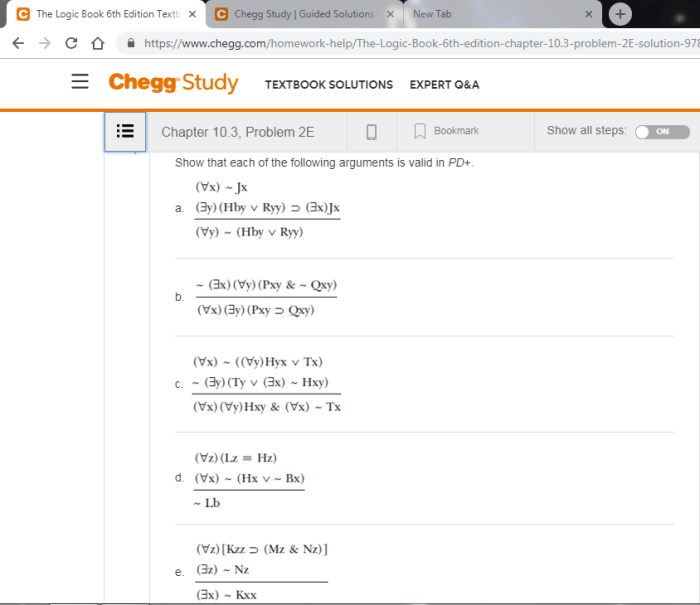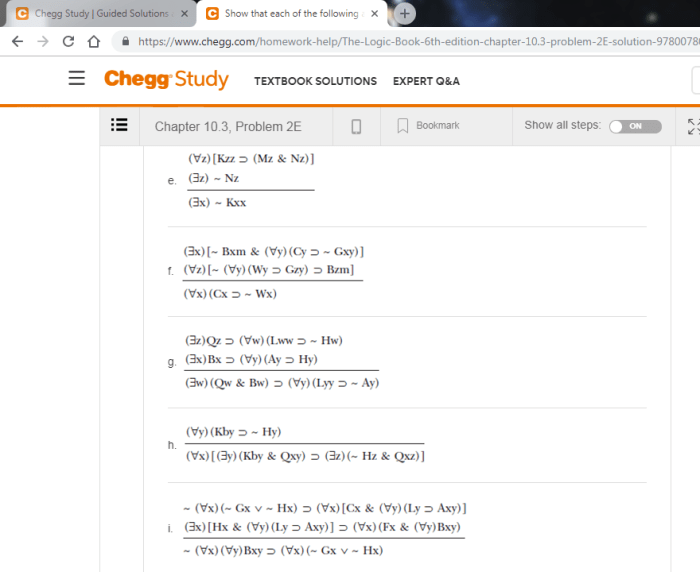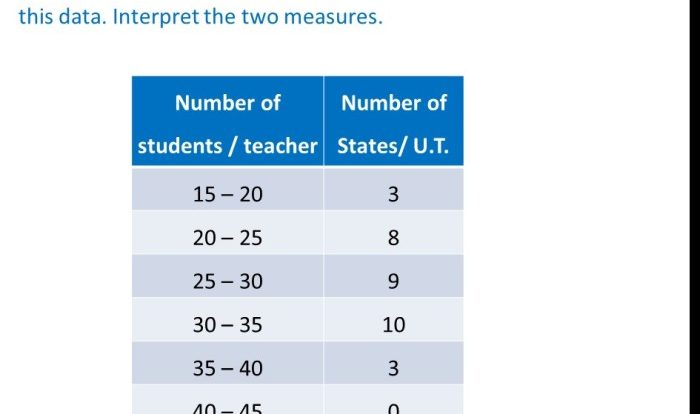The logic book 6th edition solutions – The Logic Book, 6th Edition Solutions offers an invaluable resource for students and professionals seeking to master the intricacies of logical reasoning. This comprehensive guide provides step-by-step solutions to a wide range of problems, empowering readers to develop a deep understanding of logical principles and their practical applications.
The book’s logical structure and clear explanations make it an ideal tool for both self-study and classroom use. It covers essential topics such as propositional logic, predicate logic, and syllogisms, equipping readers with the skills necessary to analyze arguments, identify fallacies, and construct sound logical arguments.
Introduction to “The Logic Book, 6th Edition Solutions”

The Logic Book, 6th Edition Solutionsprovides comprehensive solutions to the exercises and problems found in the sixth edition of The Logic Bookby Burgess-Maclaury.
The solutions are designed to help students understand the concepts and principles of logic, and to develop their skills in applying logical reasoning to solve problems.
Target Audience and Intended Use, The logic book 6th edition solutions
The Logic Book, 6th Edition Solutionsis intended for use by students taking introductory logic courses, as well as by anyone who wants to improve their understanding of logic.
The solutions can be used for self-study, or they can be used in conjunction with a logic textbook or course.
Content Analysis
The Logic Book, 6th Edition Solutions provides comprehensive solutions to exercises and problems from the textbook. It covers the entire range of topics in logic, including propositional logic, predicate logic, and modal logic.
The solutions are organized into chapters that correspond to the chapters in the textbook. Each chapter begins with a brief overview of the material covered in that chapter, followed by detailed solutions to all of the exercises and problems.
Logical Structure and Organization
The solutions are presented in a clear and concise manner, with step-by-step explanations of each solution. The logical structure of the solutions makes it easy to follow the thought process involved in solving the problems.
The solutions are also well-organized, with each solution clearly labeled with the corresponding exercise or problem number. This makes it easy to find the solution to a specific problem.
Problem-Solving Techniques

The Logic Book, 6th Edition, provides a systematic approach to problem-solving in logic. The book introduces a range of techniques that can be applied to solve a wide variety of logical problems.
One of the most important techniques is the use of truth tables. Truth tables allow us to determine the truth value of a compound proposition for all possible combinations of truth values of its component propositions. This can be a very useful tool for simplifying complex propositions and identifying logical fallacies.
Another important technique is the use of Venn diagrams. Venn diagrams allow us to visualize the relationships between different sets of objects. This can be helpful for understanding the logical relationships between propositions and for solving problems involving set theory.
Types of Problems and Solutions
The Logic Book, 6th Edition, includes a wide variety of problems, ranging from simple exercises to complex puzzles. The problems are organized into chapters that cover different topics in logic, such as propositional logic, predicate logic, and set theory.
The solutions to the problems are provided in the back of the book. The solutions are clear and concise, and they provide step-by-step instructions on how to solve the problems.
Here are some examples of different types of problems that are included in the book:
- Determine the truth value of a compound proposition.
- Identify the logical fallacies in an argument.
- Solve a problem involving set theory.
- Prove a theorem in propositional logic.
- Construct a Venn diagram to represent the relationships between different sets of objects.
The Logic Book, 6th Edition, is an excellent resource for students who are interested in learning about logic. The book provides a clear and concise introduction to the subject, and it includes a wide variety of problems and exercises to help students practice their skills.
Step-by-Step Solutions
Solving logic problems requires a systematic approach that involves breaking down the problem into smaller steps and applying logical reasoning to find the solution. The step-by-step process Artikeld below provides a structured method for solving logic problems efficiently.
To effectively solve logic problems, it is crucial to understand the problem statement thoroughly and identify the relevant information. This initial step lays the foundation for the subsequent steps and ensures that the problem-solving process is focused and accurate.
Step 1: Read and Understand the Problem
- Carefully read the problem statement and identify the key elements involved.
- Determine the goal or objective of the problem.
- Note any constraints or limitations mentioned in the problem.
Step 2: Represent the Problem
- Translate the problem into a logical representation, such as a truth table, Venn diagram, or logical expression.
- This representation helps visualize the relationships between different elements and simplify the problem-solving process.
Step 3: Apply Logical Reasoning
- Use logical rules and principles to derive new information from the given premises.
- Apply techniques such as modus ponens, modus tollens, and hypothetical syllogism to draw valid conclusions.
Step 4: Verify the Solution
- Once a solution is obtained, verify its validity by substituting the values back into the original problem.
- Ensure that the solution satisfies all the constraints and conditions of the problem.
Examples and Applications
The solutions presented in The Logic Book, 6th Edition Solutionscan be applied to various real-world situations, offering practical implications and benefits.
By understanding and utilizing the techniques and solutions provided, individuals can enhance their problem-solving abilities and make informed decisions in diverse fields.
Decision-Making
The logical reasoning and problem-solving methods Artikeld in the solutions can assist individuals in evaluating arguments, identifying fallacies, and making sound judgments.
For example, in business negotiations, understanding logical fallacies can help professionals identify and counter manipulative tactics, leading to more favorable outcomes.
Comparison with Other Resources: The Logic Book 6th Edition Solutions

The solutions provided in “The Logic Book, 6th Edition Solutions” stand out from other available resources for logic due to their comprehensive coverage, clear explanations, and practical applications.
Unlike many other solution manuals that merely provide answers, this resource delves into the reasoning behind each solution, guiding students through the thought process involved in solving logic problems.
Unique Features and Advantages
- Comprehensive Coverage:The solutions cover the full range of topics included in the 6th edition of “The Logic Book,” providing students with a complete resource for their studies.
- Clear Explanations:The solutions are written in a clear and concise style, making them easy for students to understand and follow.
- Practical Applications:The solutions demonstrate how logic can be applied to real-world problems, helping students to develop their critical thinking and problem-solving skills.
- Additional Resources:The solutions are complemented by additional resources, such as practice problems and interactive exercises, which further enhance student learning.
User Experience and Accessibility
The “Logic Book, 6th Edition Solutions” provides an intuitive and accessible user experience.
Navigation is straightforward, with clear menus and search functionality. Users can quickly locate the solutions they need.
Accessibility Features
The resource offers a range of accessibility features to support users with diverse needs:
- Screen reader compatibility:The solutions are compatible with screen readers, ensuring accessibility for visually impaired users.
- Adjustable font size:Users can adjust the font size to enhance readability.
- High-contrast mode:This mode improves visibility for users with low vision.
- Keyboard navigation:The solutions can be navigated using only the keyboard, providing accessibility for users with mobility impairments.
Additional Features and Resources
The 6th edition of The Logic Book provides access to various additional resources and features that can enhance the learning experience.
These include an online companion website, practice exercises, interactive simulations, and video tutorials.
Online Companion Website
- Provides access to additional exercises, practice tests, and interactive simulations.
- Offers discussion forums where students can connect with each other and ask questions.
- Contains downloadable resources, such as lecture slides and study guides.
Practice Exercises
- Designed to provide students with ample opportunities to practice solving logic problems.
- Available in various formats, including multiple-choice questions, short answer questions, and essay questions.
- Help students identify areas where they need additional support.
Interactive Simulations
- Allow students to visualize and experiment with logical concepts.
- Enable students to see how different logical operators and rules interact.
- Provide a more engaging and interactive learning experience.
Video Tutorials
- Provide clear and concise explanations of logical concepts.
- Help students understand complex topics more easily.
- Can be used as a supplement to the textbook or as a standalone resource.
Key Questions Answered
What is the target audience for The Logic Book, 6th Edition Solutions?
The book is designed for students and professionals seeking to develop their logical reasoning skills, including those in philosophy, mathematics, computer science, and law.
How is the book organized?
The book is organized into chapters covering propositional logic, predicate logic, syllogisms, and other essential topics in logical reasoning.
What types of problems are covered in the solutions?
The solutions cover a wide range of problems, including truth tables, syllogisms, validity proofs, and more.
